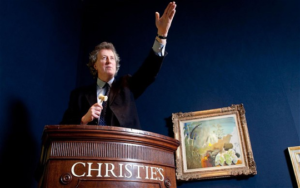Fine art is a status symbol, both in societal terms and economic terms. The uber-wealthy pull out their wallets at art auctions hosted by Christie’s and Sotheby’s every year and contest for collectable pieces by the world’s greatest artists. The prices naturally fluctuate with the ebbs and flows of the global economy so when buyers up the ante, those price tags can be used as a gauge for confidence in the market. The more money people have, the more likely they will spend it. According to the Washington Post, Christie’s auction house set a record this year by auctioning off the most expensive painting in history. Leonardo da Vinci’s, “Saviour of the World” (Salvador Mundi) was auctioned off for an astounding $450,312,500, shattering the previous record by over $270 million dollars. Spending that kind of money on a collector’s item is a direct result of the economy as a whole and the conviction the wealthy have in it.
Economic indicators come in many forms, but art is one that could be considered unorthodox given only the wealthiest of society participate. Art auctions like Christie’s is an interesting way to look at the health of the economy. Price tags like the one on Leonardo da Vinci’s painting are not small and the growing economy allows for pieces like that to go for hundreds of millions of dollars. Fortune magazine examines the art auction market a little deeper saying “robust sales are a sign the world’s wealthiest people feel bullish—making a recovering art market something that point-one-percenters and the other 99.9% can be equally excited about.” The art industry as a whole has been in a slump since 2015 so the numbers being reflected in this year’s auctions are a good sign for the industry and the shareholders of the auction houses. Confidence in the buyers also creates confidence in the sellers. That confidence stems from a myriad of elements including a sky-high Dow Jones, planned tax cuts from the Trump administration and other indicators that signifying a robust marketplace.
 According to the New York Times, the tax cuts also include a provision that restricts “high-end art investors to sell works and quickly replace them with pieces of similar value and [thus] defer paying federal taxes.” If passed, this loophole in the system could potentially halt liquidity in the U.S. market to some extent because people will sell less and not have as much money to spend. With that being said, the current art market is sitting pretty at $60 billion, but is mostly made up of pieces that go for $1 or $2 million, unlike da Vinci’s piece, with buyers who hope to use those “smaller” purchases as an investment that they can gain profit on by resale down the road. The fact that material objects can generate this much revenue is surprising in a time where people are starting to value experiences more and more in society. Although it is not the strongest indicator, the confidence in the art market is very telling in a macro-economic sense. It will be interesting to see how long the confidence remains and if the economy really starts to reflect the experience-leaning consumerist shift or if fine art will continue to be as expensive. In the art world, some of the wealthiest people in the world invest in timeless pieces of art that also help excite a market that only the 1% can participate in. Fine art as an economic indicator is one that you will only see thriving when the economy is hot, and thriving to the extent where a few hundred million dollars is spent on a single work of art. That is not chump change, so when that kind of money is used to purchase a collector’s item, it is easy to assume that the economy is doing well and expected to do so for the near future.
According to the New York Times, the tax cuts also include a provision that restricts “high-end art investors to sell works and quickly replace them with pieces of similar value and [thus] defer paying federal taxes.” If passed, this loophole in the system could potentially halt liquidity in the U.S. market to some extent because people will sell less and not have as much money to spend. With that being said, the current art market is sitting pretty at $60 billion, but is mostly made up of pieces that go for $1 or $2 million, unlike da Vinci’s piece, with buyers who hope to use those “smaller” purchases as an investment that they can gain profit on by resale down the road. The fact that material objects can generate this much revenue is surprising in a time where people are starting to value experiences more and more in society. Although it is not the strongest indicator, the confidence in the art market is very telling in a macro-economic sense. It will be interesting to see how long the confidence remains and if the economy really starts to reflect the experience-leaning consumerist shift or if fine art will continue to be as expensive. In the art world, some of the wealthiest people in the world invest in timeless pieces of art that also help excite a market that only the 1% can participate in. Fine art as an economic indicator is one that you will only see thriving when the economy is hot, and thriving to the extent where a few hundred million dollars is spent on a single work of art. That is not chump change, so when that kind of money is used to purchase a collector’s item, it is easy to assume that the economy is doing well and expected to do so for the near future.
Leave a Reply
You must be logged in to post a comment.